Funding complications, absent greats and tactical quandaries – Gravel World Championships talking points
A closer look at key issues kicking up dust on run-in to third edition of UCI gravel world title chase
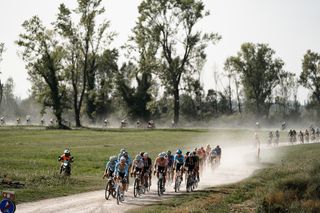
The third edition of the UCI Gravel World Championships is set to play out in Belgium, with a Classics-style course due to decide the competition for the rainbow jerseys on Saturday, October 5 and Sunday, October 6.
There are plenty of WorldTour road professionals joining the riders who make more regular gravel appearances, and overall numbers on the start line are ballooning. A more organised lead-up is surely helping the steady rise in momentum behind what is now a far more well-established event.
The chaos and uncertainty of the first two editions look to be a thing of the past. Courses have been announced well ahead of time, firm broadcast details are in place for both the women's and men's races and there is a well-laid path ahead for the racing for many years to come.
Gravel is still, however, a relatively new and evolving UCI discipline, with wrinkles to iron out and growing pains to grapple with, and that keeps discussion swirling. We take a closer look at five of the key talking points that are drawing attention ahead of the riders lining up in Halle this weekend.
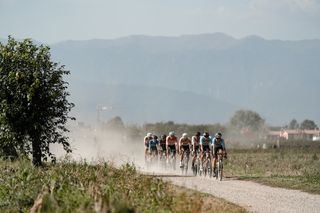
Why some gravel greats aren’t lining up
As the announcements of the UCI Gravel World Championships teams started rolling out, at times the riders who were missing from the list were as telling as those who were on it.
One of the earlier team announcements came from AusCycling, who said that their men’s elite gravel national champion Brendan Johnston wouldn’t be taking his automatic qualification spot.
Then came the release of the United States team, the stronghold of gravel. There was no Keegan Swenson, who declined to take the wildcard entry he was offered. He was the nation’s top UCI Gravel World Championships finisher in 2023 with fifth and he remains the rider to beat on the prestigious US gravel scene, having just won a fourth race in the Life Time Grand Prix.
Swenson also wasn’t alone in knocking back the invite. US riders Paige Onweller, Russell Finsterwald, Lauren De Crescenzo and Alexis Skarda all opted not to go. Argentina’s Sofia Gomez Villafane, who resides in the US and leads the elite women's standings of the Life Time Grand Prix, was another dominant player in the US gravel scene to pass on a trip to Belgium.
So why wouldn’t riders line up to represent their nation and chase a rainbow jersey when given the chance? Well, there are a number of reasons.
Firstly, the UCI Gravel World Championships isn’t exactly the normal course or style of racing many gravel specialists are accustomed to. The gravel and paved proportions have tended to hover around 50/50 at the UCI rainbow races and distances have been more aligned with typical road race distances than the long-range gravel efforts seen in the US – with the contrast amplified in the women's field as the elite women's race is shorter than the men's event.
Those course and distance factors favour the WorldTour road professionals who opt to line up at the rainbow race, leaving gravel riders on the back foot even before they make it to the start line. When they do, those who exist in the non-UCI gravel world also don't generally have the points to command a position near the front of the grid.
Get The Leadout Newsletter
The latest race content, interviews, features, reviews and expert buying guides, direct to your inbox!
Factor in the financial impost for riders who are trying to carve out a living in a far less lucrative discipline and it is no wonder that riders who have to take a long and costly flight across time zones to make it to the World Championships are thinking twice about whether it is worth it. That's resulted in a situation where the Gravel World Championships is playing out without a number of the biggest names in the discipline.
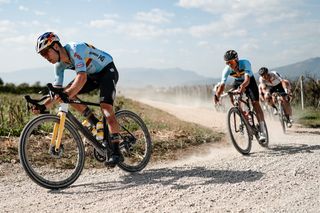
The funding complication
For teams at the Road World Championships there are strict team quotas and generally strict selection policies and team orders as well as funding to help riders along the way. Gravel, however, is a completely different scenario.
There are two key routes for elite rider selection, the UCI Gravel World Series – with the last eligible rounds just two weeks before the Championships – and wildcards granted by the federations. That means the number of riders from each nation can run to a long list, and is to a considerable extent out of a federation’s control and isn’t confirmed until the last minute. That clearly creates a different scenario for a national cycling organisation to deal with than in the Road Worlds and it is clear that less than three years in, many are still working through just how this new discipline fits.
Last year USA Cycling delivered supported spots for the winners of the USA Gravel National Championships. But this year it made clear in its selection documents that "athletes who receive automatic invitations from the UCI or are nominated by the USA Cycling Athlete Discretionary Selection procedures are responsible for the full expense associated with this event".
AusCycling also works on a primarily self-funded approach, with some “basic admin support and funded clothing” while British Cycling also runs along the self-funded model.
While the allocation of resources is never easy, particularly in an Olympic year with funding models that are often medal-focused, it still leads to a situation that leaves many athletes with a quandary.
Do they represent their nation at a significant cost – both in time and financially – and also potentially forgo their bread-and-butter races in the process? Given the current circumstances, it’s no wonder then that some of the best have decided that they can’t afford the luxury of chasing rainbows.
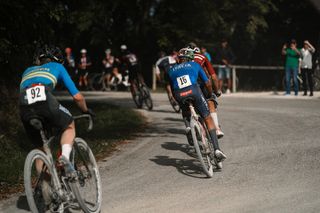
Team tactics - Nation or trade?
A consequence of the aforementioned tendency for there not to be widespread support for national gravel teams is that many riders who can make the race are left looking to their trade teams for on-the-ground support, from accommodation to mechanical and feed zone support. That begs the question, if the trade teams are funding the effort, are riders really racing with their national allegiances first and foremost, or is it the trade teams that are there supporting them that take precedence?
While gravel can often be an individual support, the more road race-style courses definitely open the prospect that team tactics could be crucial. In fact even at the very first UCI Gravel World Championships, with Gianni Vermeersch out the front it appeared that key favourite Mathieu van der Poel was reluctant to try to shut down his Alpecin-Deceuninck teammate.
Clearly trade team alliances and friendships can have an influence on the road as well, but at least then when federations are calling the shots, making the selections, providing the staff and paying the bills the first priority is clear. No matter what jersey a rider may be wearing when they race, when all the support is coming from elsewhere it's understandable that this may be where the loyalties lie.
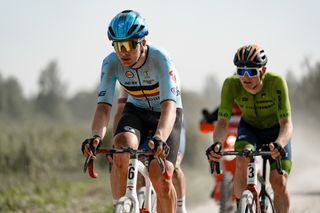
Waiting for a gravelly 2026
How much gravel is in a UCI Gravel World Championships? About 50 percent or so is the answer based on what we have seen so far.
The UCI incarnation of gravel racing is a version that isn't quite as gravelly as some sections of the discipline, with the courses so far playing to the strengths of the road specialists rather than the gravel devotees. This is the proof, perhaps, that Unbound Gravel winners don't necessarily thrive at the World Championships and, judging by Matej Mohorič's 2024 sortie, riders wearing the rainbow jersey don't necessarily thrive at Unbound either.
Even the style of courses within the UCI Gravel World Series itself vary considerably. The more road style distances and routes have definitely helped build the broader interest in the discipline, with the big WorldTour names drawing plenty of attention. However, that's left some raising the question of when can we have a little more gravel in the Gravel World Championships?
Erwin Vervecken, manager of the Gravel World Series and the UCI Gran Fondo, points out that a full gravel course is easier to find in some locations than others, and that the terrain will vary as the locations move, leaning towards different types of riders.
"That's also the case in the Road World Championships – one year you have a mountain course, the next year you have a totally flat course for sprinters," Vervecken told Cyclingnews. "Nannup, for instance, in two years, will be a 90% or 95% gravel course. This year it's a bit more 50/50 but still if you organise the World Championships in Belgium. It's hard to find a full gravel course."
So the gravel purists will have their day, but they'll have to wait until 2026 when the World Championships heads to a remote corner of Western Australia where the gravel roads stretch as far as the eye can see.
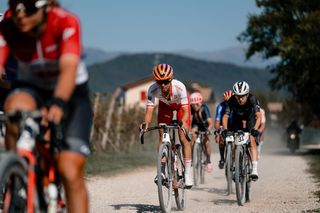
Banishing the growing pains
The UCI Gravel World Championships may still be evolving, but it looks like the most extreme of the growing pains are over. The limited runway in the first year understandably meant it was a last minute course announcement which made it difficult for riders travelling from far and wide to commit early enough to what was essentially a largely unknown race. The second year too didn't quite run to plan, with a last minute change in organiser and uncertainty with a broadcast, the end result being that it was delivered for just the men's race and not the women's.
The contrast, however, in 2024 has been marked. The Belgian course has long been laid out, with riders even getting a sneak peek of the terrain at the European Gravel Championships in 2023. Riders have time to plan, evident in the numbers which have rocketed to over 2,000 and include a growing number of international competitors. Broadcast plans for the men's and women's race have also been set in stone for some time.
The event this year has far more in common with what we've come to expect from a race for the rainbow jersey, and with information already trickling out on what's ahead for 2025 and 2026 it looks like that momentum will just keep rolling through the years ahead.

Get unlimited access to all of our coverage of the 2024 UCI Gravel World Championships - including breaking news and analysis reported by our journalists on the ground from the elite women's and elite men's events as it happens and more. Find out more.

Thank you for reading 5 articles in the past 30 days*
Join now for unlimited access
Enjoy your first month for just £1 / $1 / €1
*Read any 5 articles for free in each 30-day period, this automatically resets
After your trial you will be billed £4.99 $7.99 €5.99 per month, cancel anytime. Or sign up for one year for just £49 $79 €59

Join now for unlimited access
Try your first month for just £1 / $1 / €1

Simone is a degree-qualified journalist that has accumulated decades of wide-ranging experience while working across a variety of leading media organisations. She joined Cyclingnews as a Production Editor at the start of the 2021 season and has now moved into the role of Australia Editor. Previously she worked as a freelance writer, Australian Editor at Ella CyclingTips and as a correspondent for Reuters and Bloomberg. Cycling was initially purely a leisure pursuit for Simone, who started out as a business journalist, but in 2015 her career focus also shifted to the sport.